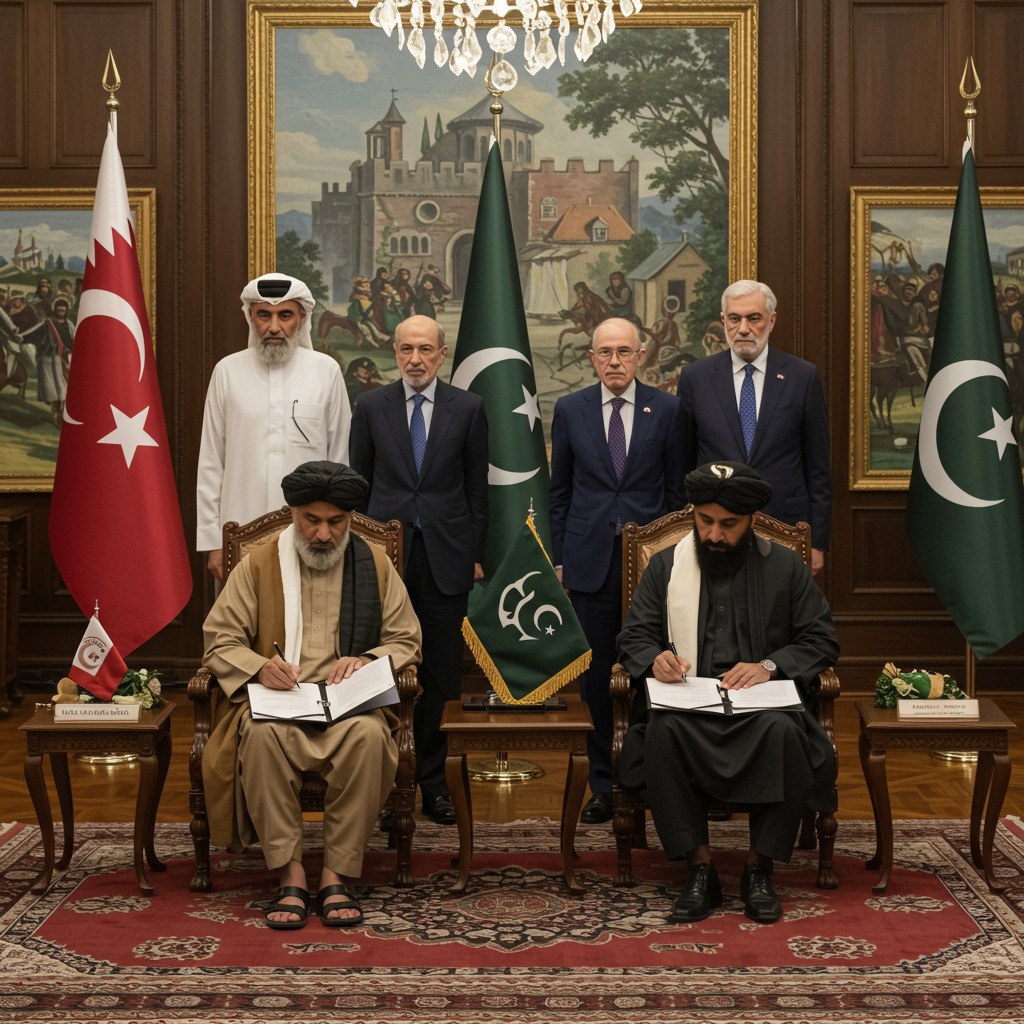A critical diplomatic breakthrough has emerged from a volatile region: Pakistan and Afghanistan’s interim Taliban government have agreed to an immediate ceasefire. This pivotal accord follows more than a week of intense and deadly cross-border clashes, marking the most severe escalation of hostilities between the two nations since the Taliban regained power in Kabul in 2021. Mediated by the diplomatic efforts of Qatar and Turkey, the agreement seeks to establish concrete mechanisms for fostering lasting peace and stability along their shared, mountainous 1,600-mile border.
The immediate cessation of hostile actions, as emphasized by Taliban spokesman Zabihullah Mujahid, represents a crucial first step. Pakistan’s foreign minister echoed this sentiment, calling the agreement “the first step in the right direction.” However, the path ahead remains complex, fraught with historical grievances and deeply entrenched security concerns that have plagued relations for years.
De-escalating a Deadly Border Conflict
The recent surge in cross-border violence began earlier this month, plunging relations to their lowest point in years. Both sides exchanged accusations, escalating tensions rapidly. The Afghan Taliban initially accused Pakistan of carrying out airstrikes on Kabul, the Afghan capital, on October 9. These alleged strikes reportedly followed unverified rumors circulating about a targeted attack on Noor Wali Mehsud, the leader of the Tehrik-i-Taliban Pakistan (TTP), a militant group operating within Pakistan. Mehsud later released a voice note to confirm his survival, but the accusations had already fueled a dangerous retaliation cycle.
In the days that followed, Afghan troops reportedly fired on Pakistani border posts, prompting robust responses from Pakistan. Islamabad retaliated with mortar fire and drone strikes, asserting its right to self-defense against what it termed “unwarranted aggression.” The human cost was tragically high: the UN Assistance Mission in Afghanistan reported that at least three dozen Afghan civilians were killed and hundreds more wounded. The Afghan Taliban later accused Pakistan of a specific air strike that killed eight people, including three local cricket players, an incident which led Afghanistan to withdraw from an upcoming cricket series with Pakistan. This sequence of events underscored the urgent need for a ceasefire.
The Core Grievance: Pakistan’s Militancy Problem
At the heart of Pakistan’s long-standing grievances is its accusation that the Afghan Taliban harbors armed groups, particularly the Tehrik-i-Taliban Pakistan (TTP), often referred to as the Pakistan Taliban. Islamabad blames the TTP, and occasionally the Balochistan Liberation Army (BLA), for a significant surge in terrorist attacks within its territory. Data from the Armed Conflict Location & Event Data Project (ACLED) indicates the TTP alone has conducted over 600 attacks on Pakistani forces in the past year. The Center for Research and Security Studies (CRSS), an Islamabad-based think tank, further reported a staggering 2,414 deaths in the first three quarters of 2025 due to violence, marking a 46 percent surge compared to the previous year.
Despite these accusations, Kabul consistently denies providing safe haven to the TTP. The Afghan Taliban maintains its long-held stance that Afghan soil “will not be allowed to be used against any other country.” While the TTP’s ideology aligns with the Afghan Taliban, the groups reportedly operate independently, adding a layer of complexity to Pakistan’s demands for control. This ongoing dispute over the alleged sanctuary for militants forms the most significant obstacle to enduring peace.
Terms of the Breakthrough Ceasefire Agreement
The agreement, forged during intensive negotiations in Doha, Qatar, outlines specific commitments from both Pakistan and the Afghan Taliban. A fundamental tenet is the “immediate cessation of fighting” and the establishment of “mechanisms to consolidate lasting peace and stability.” Key terms include:
End to Hostile Actions: Both countries explicitly committed to refraining from engaging in hostile actions against each other.
No Support for Anti-Pakistan Groups: Crucially, the Taliban agreed not to “support groups carrying out attacks against the Government of Pakistan.” This directly addresses Islamabad’s primary security concern regarding the TTP.
Protection of Civilians and Infrastructure: Both sides pledged to refrain from targeting each other’s security forces, civilians, or critical infrastructure.
Sovereignty and Territorial Integrity: Pakistan’s Defense Minister Khawaja Asif confirmed that both nations would uphold each other’s sovereignty and territorial integrity, with cross-border terrorism from Afghan territory expected to cease immediately.
Deputy Prime Minister and Foreign Minister Ishaq Dar underscored the need for a “concrete and verifiable monitoring mechanism” to address terrorism originating from Afghan soil. Such a mechanism, he stated, would be essential in preventing further loss of lives and ensuring the ceasefire’s sustainability.
A Turbulent History: From Support to Strain
The relationship between Pakistan and the Taliban has undergone a significant transformation. Historically, Pakistan was a major backer of the Taliban after its ouster in 2001 following the US-led invasion. Islamabad was even accused of sheltering Taliban fighters during the subsequent US occupation. However, relations deteriorated sharply, especially with the re-emergence of the TTP as a potent national security threat to Pakistan.
Islamabad’s growing frustration stemmed from its perception that the Afghan Taliban, once a close ally, was now providing safe haven and logistical support to the TTP, which wages an armed insurgency against Pakistani government forces. This shift in allegiance, or at least perceived inaction, created a deep rift. Adding to the complexity is the unresolved dispute over the Durand Line, the 2,600km (1,600-mile) international border, which Pakistan recognizes but Afghanistan does not, further complicating border management and security.
Navigating Future Talks and Monitoring Challenges
Looking ahead, further crucial talks are scheduled to take place in Istanbul, Turkey, next week. These follow-up meetings are designed to delve deeper into the implementation of the ceasefire and establish the verification mechanisms deemed vital by Pakistan. The success of these discussions will largely determine the longevity and effectiveness of the current agreement.
The challenges to maintaining this peace are substantial. Previous attempts at de-escalation have faltered; for instance, Taliban-mediated talks between the Pakistani military and the TTP in 2021 saw a temporary decrease in violence. However, the TTP unilaterally withdrew from that ceasefire in 2022, accusing Islamabad of renewing military operations, leading to a renewed surge in attacks. As political analyst Abdullah Baheer aptly noted, “This logic of bombing Afghanistan into submission didn’t work for the United States for 20 years of their occupation. Why do we think it will work now?” emphasizing that “there are no winners in war. There are only losers.” This sentiment highlights the need for diplomatic, not just military, solutions.
Frequently Asked Questions
What specific accusations led to the recent Pakistan-Afghanistan clashes?
The recent intense clashes were fueled by mutual accusations. The Afghan Taliban accused Pakistan of carrying out airstrikes in Kabul, allegedly targeting TTP leader Noor Wali Mehsud. Pakistan, in turn, condemned what it called “unwarranted aggression” by the Afghan Taliban, accusing them of initiating attacks along the shared border. Islamabad claims these attacks originated from Afghan soil, where it believes armed groups like the TTP find refuge, leading to retaliatory actions including mortar fire and drone strikes from Pakistan.
Which international bodies mediated the Pakistan-Taliban ceasefire talks?
The critical ceasefire agreement between Pakistan and Afghanistan’s interim Taliban government was successfully mediated by two key international facilitators. Both Qatar and Turkey played instrumental roles in bringing the warring parties to the negotiating table in Doha, Qatar. Their diplomatic efforts were crucial in fostering dialogue and securing the commitments necessary for an “immediate ceasefire” and the framework for establishing “lasting peace and stability.”
What are the main challenges to maintaining the newly agreed ceasefire between Pakistan and the Afghan Taliban?
Maintaining the ceasefire faces several significant challenges. A primary concern is Pakistan’s demand for the Afghan Taliban to genuinely control and prevent armed groups like the TTP from operating against Pakistan from Afghan soil, an accusation Kabul denies. The historical mistrust, the unresolved Durand Line border dispute, and the operational independence of groups like the TTP despite ideological ties, complicate enforcement. Establishing a “concrete and verifiable monitoring mechanism” for cross-border terrorism will be crucial, as past peace attempts have failed due to breaches and renewed hostilities.
The Fragile Hope for Regional Stability
This immediate ceasefire represents a moment of cautious optimism amidst deep-seated regional instability. While the agreement addresses critical concerns, particularly Pakistan’s demand for an end to cross-border terrorism, its long-term success hinges on robust implementation and verifiable monitoring. The upcoming talks in Istanbul will be crucial for solidifying these mechanisms and transforming a temporary truce into a sustainable peace. The international community will closely watch whether this diplomatic overture can finally bring an end to the deadly cycle of violence along one of the world’s most volatile borders, paving the way for improved bilateral relations and enhanced regional security.




